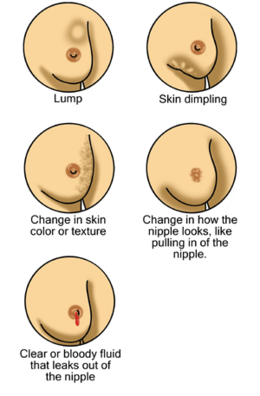Breast disease: Difference between revisions
No edit summary |
|||
| Line 47: | Line 47: | ||
* bacterial mastitis |
* bacterial mastitis |
||
* mastitis from milk engorgement or secretory [[stasis (medicine)|stasis]] |
* mastitis from milk engorgement or secretory [[stasis (medicine)|stasis]] |
||
* mastitis |
* mastitis |
||
* chronic [[subareolar abscess]] |
* chronic [[subareolar abscess]] |
||
* [[tuberculosis]] of the breast |
* [[tuberculosis]] of the breast |
||
Revision as of 00:30, 30 October 2018
| Breast disease | |
|---|---|
| Other names | Breast problems |
| Specialty | Gynecology |
Breast diseases make up a number of conditions. The most common symptoms are a breast mass, breast pain, and nipple discharge.[1]
A majority of breast diseases are noncancerous.[2]
Tumor

A breast tumor is an abnormal mass of tissue in the breast as a result of neoplasia. A breast neoplasm may be benign, as in fibroadenoma, or it may be malignant, in which case it is termed breast cancer. Either case commonly presents as a breast lump. Approximately 7% of breast lumps are fibroadenomas and 10% are breast cancer, the rest being other benign conditions or no disease.[3]
Phyllodes tumor is a fibroepithelial tumor which can either benign, borderline or malignant.
Breast cancer
Among women worldwide, breast cancer is the most common cause of cancer death.[4] Breast self-examination (BSE) is an easy but unreliable method for finding possible breast cancer.[5] Factors that appear to be implicated in decreasing the risk of, early diagnosis of, or recurrence of breast cancer are regular breast examinations by health care professionals, regular mammograms, self-examination of breasts, healthy diet, and exercise to decrease excess body fat.[6]
Fibrocystic breast changes
Also called: fibrocystic breast disease, chronic cystic mastitis, diffuse cystic mastopathy, mammary dysplasia
Infections and inflammations
These may be caused among others by trauma, secretory stasis/milk engorgement, hormonal stimulation, infections or autoimmune reactions. Repeated occurrence unrelated to lactation requires endocrinological examination.
- bacterial mastitis
- mastitis from milk engorgement or secretory stasis
- mastitis
- chronic subareolar abscess
- tuberculosis of the breast
- syphilis of the breast
- retromammary abscess
- actinomycosis of the breast
- duct ectasia syndrome
- breast engorgement
Other breast conditions
- Mondor’s disease
- Paget's disease of the breast
- nipple discharge, galactorrhea
- breast cyst
- mastalgia
- galactocoele
See also
References
- ^ Salzman, B; Fleegle, S; Tully, AS (15 August 2012). "Common breast problems". American family physician. 86 (4): 343–9. PMID 22963023.
- ^ "MedlinePlus: Breast Diseases".
- ^ Page 739 in: Mitchell, Richard Sheppard; Kumar, Vinay; Abbas, Abul K.; Fausto, Nelson. Robbins Basic Pathology. Philadelphia: Saunders. ISBN 1-4160-2973-7. 8th edition.
- ^ World Health Organization (February 2006). "Fact sheet No. 297: Cancer". Retrieved 2007-04-26.
- ^ Breast Self Examination at The Breast Site
- ^ Seven things you should know about breast cancer risk Harvard College. Last updated June 2008
Further reading
- Irshad, A.; Ackerman, S. J.; Pope, T. L.; Moses, C. K.; Rumboldt, T.; Panzegrau, B. (2008). "Rare Breast Lesions: Correlation of Imaging and Histologic Features with WHO Classification1". Radiographics. 28 (5): 1399–1414. doi:10.1148/rg.285075743. PMID 18794315.
